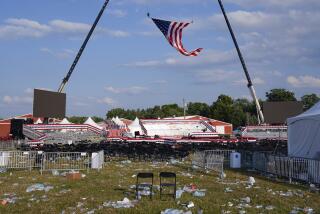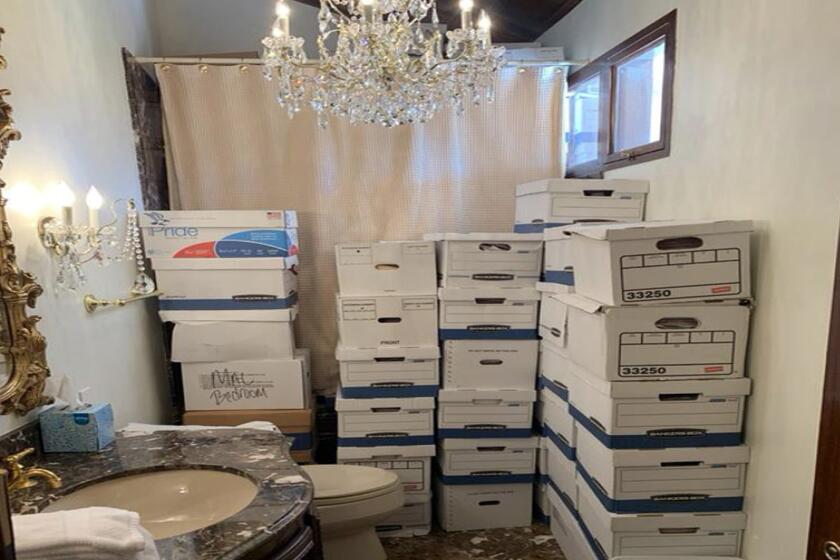Eight Workers Feared Dead in Russian Cosmodrome Collapse
Eight men were feared dead after plunging about 260 feet to earth when a roof at the Baikonur cosmodrome in Kazakhstan collapsed Sunday.
The men were repairing the roof of the Russian space shuttle hangar at the cosmodrome, the principal location for Russia’s rocket launches, when three of five columns supporting the roof fell, burying the construction team in rubble.
Immediate rescue efforts proved impossible because of high winds and unstable walls.
A team of 30 rescue workers from the Russian Ministry of Emergency Situations flew to Baikonur, about 1,300 miles southeast of Moscow, late Sunday, but officials were pessimistic about finding any of the eight repair workers alive.
The 1980s building, a vast Soviet-era hangar used to house the Buran space shuttle, was poorly built and in bad condition.
Sergei A. Gorbunov, spokesman for the Russian Space Agency, said in a telephone interview that it was unlikely the eight workers could have survived such a fall.
He said there was a model of the Buran space shuttle in the building when the roof caved in. The Buran project is defunct: The craft flew only once, 14 years ago, then became a space dinosaur.
The collapse underlines Russia’s problems upgrading big, decaying Soviet-era infrastructure, not just in the space industry but in the military and many other sectors--some privatized, some still controlled by the state.
Russia is plagued by fires--such as a devastating blaze at the Ostankino television headquarters in Moscow nearly two years ago--along with breakdowns, air crashes, oil spills and other mishaps, often due to aging infrastructure.
Playing down the damage to the prestige of Russia’s space industry, Gorbunov emphasized that the building was used only for a discontinued program, not current projects.
“It was more a museum than a production facility. The building was a huge storage facility for something that had already become history, something that would never be used,” he said.
He said the Buran that flew into space is housed elsewhere.
“The fact that the building’s roof collapsed does not mean that the Russian space complex is in decline. Accidents happen in any country and under any regime,” Gorbunov said.
The building, 900 feet long and 600 feet wide, was built of concrete slabs.
“Once the roof is gone, the entire building starts to topple like a house of cards, its walls falling inside the building,” said Gorbunov. “Naturally, the building is old, and as time went by, it required more and more money to be pumped into it.”
Although located in Kazakhstan, Baikonur, formerly the centerpiece of the Soviet space program, is leased by Russia.
Contradicting Gorbunov, Lyudmila Pavlova, a Russian space engineer who worked in the collapsed building, said by telephone from Baikonur that the Buran now under rubble is the shuttle that orbited Earth, not a model.
“The whole building very much resembles what the Chernobyl nuclear power plant looked like after the meltdown,” Pavlova said.
“Unfortunately, besides being an accident that claims human lives, the collapse of the building also has a symbolic meaning. It symbolizes the decay, or rather the collapse, of Baikonur,” she said.
“Who will be willing to sign contracts with us if buildings are allowed to deteriorate to such a state that they simply tumble down by themselves? It is a painful blow to the country’s prestige and its reputation,” she said.
Deputy Emergency Situations Minister Gennady Korotkin said the Russian rescue workers’ first task was to determine the stability of the remaining structure.
“People other than specialists cannot approach the building. It is impossible now to start any rescue operation,” he said on state- controlled ORT television.
Gorbunov said storms were forecast for the next three days, complicating the rescue effort.
More to Read
Start your day right
Sign up for Essential California for news, features and recommendations from the L.A. Times and beyond in your inbox six days a week.
You may occasionally receive promotional content from the Los Angeles Times.






